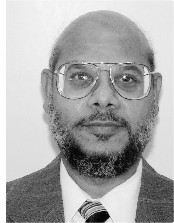

Maqsood Mohd
Associate Editor
The charter of this committee is two-fold: education and student activities. Let me take this opportunity to familiarize you with the mission, vision, and goals of this committee, and how we try to accomplish these.
Mission: To promote education related activities of the IEEE EMC Society
Vision: To provide opportunities for individuals and organizations involved with electrotechnology and products to become aware of EMC at levels consistent with their needs.
Goals:
We accomplish our goals through various means. Some I will describe here and the rest in a future article.
We provide Educational and Tutorial Workshops at the annual IEEE International Symposium on EMC. On Monday, the first day of the symposium week, a full day tutorial is organized. Six speakers who are leaders in their respective fields present their knowledge in a tutorial manner. Each educator presents his/her material for 50 minutes followed by a 10-minute question and answer period. The topics are selected based upon the theme of the conference and the needs of the local industry and students. These sessions have proven to be very informative and educational for both novice and seasoned professionals alike.
Another significant educational activity of this committee is to organize hands-on Experimental Demonstrations to explain and demonstrate in a touchy-feely way important and at times difficult to understand electromagnetic concepts. The experimental demonstrations are arranged for three days during the main symposium days (Tuesday, Wednesday, and Thursday). The experiment demonstrators are educators from academia as well as from industry. This activity is very popular among the symposium attendees. The experimental demonstrations are going to expand to the international scene starting with the Tokyo, Japan EMC conference the week of May 17, 1999.
Our members interact with their respective local area colleges and universities to educate them about the EMC field and influence the students in the EE schools to participate in the EMC field. One of the attractive mechanisms is the Student Paper Contest, which will allow the best paper author to win an expense-paid trip to the symposium. The President’s Scholarship Fund is also available for deserving students. Lastly, but not least, the Education and Student Activities Committee also awards “seed money” to start an EMC course in any university through the University Grant Fund.
To become NARTE certified in the EMC area, a workshop is conducted at every annual symposium on Mondays. Besides learning EMC material in the workshop, a few good test-taking skills are also reviewed.
This year, at the 1999 IEEE International Symposium on EMC in Seattle, we have organized the Monday Fundamentals Tutorial to include such topics as nonlinear interference effects in receivers, aircraft-triggered lightning effects, EMI due to antenna coupling, impedance of PCB ground plane, EMC in high-speed circuits, and troubleshooting tips and techniques. Speakers include Henry Ott, Howard Johnson, Daryl Gerke, Jose Perini, Don Weiner, and Rod Perala. The experimental demonstrations will be arranged for three days and some 20 experiments will be demonstrated. One highlight of this year’s experiments is an experiment about the effects of corrosion on EMC. The student paper contest is in full swing and look for some good student papers this year. Lastly, but not least, an excellent NARTE workshop on Monday and the test on Friday are also planned. So, come join us and be educated, because knowledge is power!
To conclude this column, let me share some exciting news about education. The IEEE has established an online Virtual Reading Room on the web at https://www.ieee.org/eab. You can browse through the books just like you would in a real library. Once inside the virtual room, viewers can click on any book in the best-selling IEEE Selected Readings Series or Engineers’ Guides To Business Series, and “flip through” the full text of its pages. Titles up for browsing include Cellular Radio and Personal Communications, Smart Antennas, Recent Developments in Power Electronics, Marketing for Engineers, Working in a Global Environment, Writing for Career Growth, and more!
Logical and user-friendly in its design, the reading room features:
“Having a reading room on the Internet gives visitors the opportunity to browse through books before buying them, just as they would in a traditional bookstore,” says Alan Trembly, Business Development Manager for IEEE Educational Activities. “A distribution medium such as this really enhances the IEEE’s image as practitioner of the technology of the future.” For more information about the reading room contact Alan Trembly at a.trembly@ieee.org.
To know more about your Education and Student Activities Committee or to participate in whatever way you can, please contact me at mohd@eglin.af.mil. To know more about the specific subcommittees, please contact the chair of the subcommittee. Contact any one of the following or me to become a part of the ongoing revolution in EMC engineering through education.
Vice chair
Andy Drozd (andro1@aol.com)
Chair – Student Activities
Mike Bogusz (mike_bogusz@nt.com)
Chair – Demonstrations
Andy Drozd (andro1@aol.com)
Vice Chair - Demonstrations
Larry Cohen (phone 202-404-7726)
Chair – Video Productions
Dick Ford (EMC4D@aol.com)
Chair – University Committee
John Howard (jhoward@emcguru.com)
Chair - Manual II Experiments
Jim Drewniak (drewniak@ee.umr.edu)
Chair - Standards Education
Vichate Ungvichian (ungvich@fau.edu)
Co-Chairs NARTE
Jim Whalen (jjw@ubvms.cc.buffalo.edu),
Dave Case (dcase@aironet.com)
Chair – Nominations Bob Nelson
(r.m.nelson@ieee.org)
Secretary
Bob Nelson (r.m.nelson@ieee.org)
Chair – Life-Long Learning
Kimball Williams (k.williams@ieee.org)
Chair - Continuing Education
Andy Drozd (andro1@aol.com)